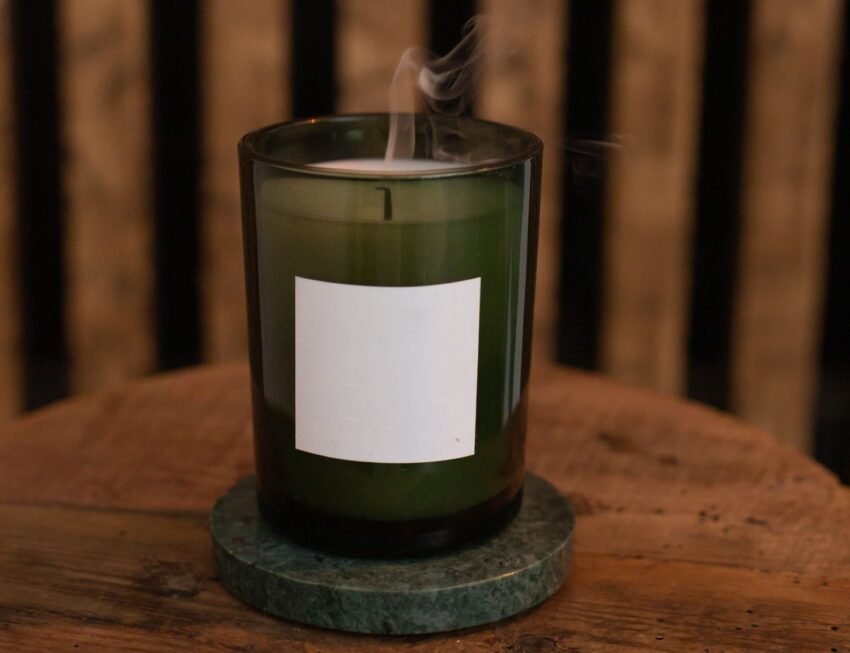Paraffin wax is the world’s most popular way of producing candles. The wax is cheap, works well with dyes and scents, is easy to mold, and if stored properly, can last almost indefinitely. But there have been lingering doubts about this wax and its effects on health.
So, are paraffin candles bad for you?
Opinions can vary to extreme ends on this topic. But, considering the overall scientific and regulatory framework in place, it appears that burning paraffin candles isn’t bad for your health.
Well, there’s a quick answer for you. But let’s get into a deeper dive and see the various aspects of this discussion slash controversy.
Are Paraffin Candles Toxic? Understanding The Claims And The Counter-Claims
Paraffin Wax Is Derived From Petroleum
If you’ve researched anything about candles or even tried to buy a candle, you might have seen the claims that say paraffin wax is toxic. A big part of this claim rests on the origins of paraffin.
I won’t go into the history of paraffin wax, but for our current discussion, it suffices to say that paraffin wax candles were invented or developed somewhere around the 1850s.
They saw a real increase in popularity in the early 1900s, coinciding with the growth in the petroleum industry.
Paraffin wax is derived from petroleum. And since the modern world is not a fan of petroleum or petroleum-derived products, paraffin wax faces some heat too.
A discussion on petroleum and its effects on the modern world is out of the scope of this article. Plenty is being said about the topic around the world.
However, for the sake of the current discussion, it should be pointed out that the origins of paraffin wax as a petroleum product does cause some people to be suspicious or even prejudiced against its use.
What Do Wax Candles Emit When They’re Lit?

Pretty much all candle waxes, including paraffin wax, are made from hydrocarbons. In a clean reaction, as a candle is lit, it should emit light, heat, water vapor, and carbon dioxide.
In a real-world scenario, the reaction is more complex and has more byproducts than the aforementioned items.
A burning candle produces carbon monoxide, soot, some particulate matter, and chemicals like benzene, formaldehyde, more volatile organic compounds (VOCs), and perhaps several others.
That list of chemicals doesn’t inspire confidence. In fact, it’s quite a scary list showing off some very bad chemicals.
The lion’s share of criticism of candle wax rests on the presence of these chemicals on burning the wax.
And it’s also the reason these waters are so muddy.
While there is no denying that these substances come from burning wax, the question is, what danger do they pose to humans?
Normally, we would turn to conventional wisdom, regulators, and scientific research for the answer.
However, in the case of burning paraffin wax, the claims get a lot more serious based on the harm these chemicals can cause, rather than what the actual threat is.
Finding The Logic Between Correlation And Causation
One of the reasons that the claims of the toxicity of paraffin wax persist, is because they’re based on some truth.
The internet is full of articles declaring the toxicity of paraffin wax with reference to the emissions from such candles.
The general theme is that candles produce benzene, and benzene in turn causes a whole list of health issues. A similar case can also be made for formaldehyde and similar substances.
Individually, both these statements are true. Candles do produce benzene and benzene is a nasty substance that can cause a lot of problems.
However, correlation does not imply causation.
An average burning candle is unlikely to produce enough of these dangerous substances to be considered a threat.
Where Does The Burden Of Proof Lie?
It’s also worth noting that many of these articles blaming paraffin wax for all these problems come from people or websites who may be considered to have special interests.
These are generally publications or businesses that are selling different kinds of wax, including soy wax, beeswax, coconut wax, and others.

Usually, these imply that paraffin wax is toxic and causes a whole lot of problems. On the other hand, the type of wax they’re selling is absolutely devoid of problems. The way things are, a beeswax seller might say that paraffin wax and soy wax are dangerous, while beeswax burns clean.
There are even a few who claim that their wax produces no undesirable chemicals.
Essentially, this would be a false claim. When a candle burns, it will emit several chemicals, including carbon monoxide, VOCs, and more, depending on the wax.
The amount of these emissions can certainly vary by the type and quality of wax. However, there is no candle that produces absolutely no objectionable substances.
So, while claims are thrown around with impunity, little to no evidence is actually provided in support of such claims.
The wider claims certainly are questionable.
Now let’s get to the meat of the matter. Where do regulators and scientific research stand on this topic?
What Does The Data And Science Say On Paraffin Wax Candles And Toxicity?
We can debate things for all eternity, but it’s the cold, hard facts that bring forth the truth. So, let’s take a closer look at what science and research say on the topic. This section will also look at candle organizations and what they have to say about burning paraffin wax candles.
The Study That Placed The Blame On Paraffin Wax
A lot of claims on the emissions of paraffin wax candles rest on a study conducted in 2009 by Ruhullah Massoudi, a chemistry professor at South Carolina State University.
The study was funded by the National Institute of Food and Agriculture (NIFA), and titled “Soybean Candles For Healthy Life And Well Being.”
The study said that paraffin candles produced a variety of nasty chemicals, including benzene, toluene, and various alkanes and alkenes. Additionally, they found soy wax candles to be clean burning.
As you can guess, the title and the findings of the study raised quite a few eyebrows. For one, the title of the study makes it seem that the study isn’t exactly impartial.
Additionally, the findings of the study were published through media and press releases on the South Carolina State University and NIFA. The study did not get published in any peer-reviewed scientific journal.
Also, while the study pointed out the presence of all sorts of chemicals, it gave no numbers on the emissions or their effects. For example, while the study said there was benzene present in the emissions, it didn’t specify whether it was in trace amounts, low amounts, or considerable amounts.
The National Candle Association (NCA) disagrees with this study and its results. In its rebuttal, amongst other things, NCA says:
No scientific study has ever shown any candle wax, including paraffin, to be harmful to human health. In fact, paraffin is approved by the U.S. Food and Drug Administration for use in food, cosmetics, and medical applications. In addition, the researchers’ data has not been published or subjected to scientific peer review to evaluate its validity, and several statements made in the release are either unsupported by data in the presentation, or serve as an overstatement of its findings.
The NCA has continued to say that it doesn’t find the aforementioned study scientifically sound or responsible.
More Scientific Research And Studies On The Use Of Candles
Thankfully, we don’t have to rely on a study conducted more than a decade ago to find real answers. There have been several studies on candles and their emissions, which are worth noting.
A study published by The Danish Environmental Protection Agency in December 2018. The study considered some types of candles, including those made from paraffin wax. The emission from any type of candle wasn’t seen as particularly troubling or dangerous. This study’s conclusion states that “Certain VOCs are emitted but at low levels consistent with finding in other studies”. Fine particulate matter was also considered and not seen as a major issue.
Personally, I see this study in a better light than most others. The Danish Environmental Protection Agency has maintained a good reputation and there don’t appear to be special interests involved with the study. Besides, the study is upfront about its data, limitations, and its findings.
Moving on, another study published in the Journal of Regulatory Toxicology and Pharmacology did not see any major health risks associated with burning scented candles, including paraffin wax candles. This study was funded by a consortium of companies organized by the Research Institute for Fragrance Materials Inc. (RIFM).
There’s another, very interesting study published in 2021, which takes a deeper look at emissions from burning candles.
This study used candles made from various kinds of wax, unscented candles, and scented candles with different fragrances. Measurements were made for the emissions of various undesirable chemicals from the burning candles.
As with most others, this study too didn’t find burning candles to be troublesome. I like that there’s a lot of data and solid numbers available with the study. The data provided with the study doesn’t show any type of candle, including paraffin wax candles to be of particular concern.
Interestingly, the data also shows that all wax types in the study (paraffin, soy, stearin, palm), release some of the undesired substances. No single type of wax can be considered to be decidedly cleaner than the others in terms of emissions.
It also shows that scented candles are likely to produce more VOCs. This is largely due to the more complex profile and burning characteristics of fragrances.
This study was at least partially funded by the National Candle Association, European Candle Association, and the Latin American Candle Manufacturers Association. Several fragrance companies also had some advisory roles.
Making Sense Of This Discussion – My Opinion And Thoughts

With this discussion, I have tried to lay out the bare facts, trying to avoid coloring them with my opinion. I’d also like to point out that there is no favoritism at play here.
I don’t sell anything, so I don’t need to twist things to suit a narrative. I’m just a hobbyist writing about my opinions and experiences.
Besides, as a reviewer and enthusiast, I use a lot of candles and other home fragrance products; arguably a lot more than the average person! I’d definitely like to know if there are risks!
Coming back to the discussion, I think there isn’t much merit to claims that say paraffin candles are bad for you.
All claims on paraffin wax candles being bad rest on a single study. Its critics are right to point out that the study doesn’t provide any specific data, and that it has never been published in a reputed scientific journal.
Even at a cursory glance, the claim that burning soy wax candles doesn’t produce any unwanted chemicals seems suspect. It is well understood that burning any type of wax candle will produce at least some amount of undesirable chemicals.
Additionally, there appears to be plenty of research backed by actual data that doesn’t find paraffin wax candles to be bad for you or of special concern over negative effects on human health.
To be clear, this doesn’t mean that paraffin wax or other types of candles don’t produce undesirable chemicals. All of them do! However, none of them show harmful emissions in an amount that would be concerning.
Most emissions remain significantly lower than the limits prescribed by various health agencies around the world.
The Correct Way To Use A Candle To Keep Pollution Low
One of the main pollutants to consider when using candles is soot. When burning, pretty much every candle will emit fine to ultrafine particles, which can be a problem in some cases. A way to considerably reduce these emissions is to burn the candle properly.
The following is generally recommended:
- Trim the candle wick to ¼ inch length before lighting it. Remove the wick trimmings. They should not fall into the candle.
- Avoid dust getting into the candle when it’s not burning. If it has a lid or cover, use it. If it doesn’t have a lid, cover it with something.
- Don’t put out a candle by blowing on it. That smoke you see (and smell) after blowing out a candle is all full of particulates.
- You can use a candle lid to put out the candle, but it’s better to use wax dippers and candle snuffers.
- Avoid placing the candle in a drafty area, so that the candle flame doesn’t flicker. This can also cause uneven burning and incomplete combustion, which increases particulate matter and other pollutants.
- Never use water to put out a candle.
- Most candles shouldn’t be lit continuously for more than four hours. By this time, the wick would be too large for a good burn. If it’s a candle in a container, the wax pool would be too large to properly sustain the wick, causing it to bend.
Candles burning for a very long time can run into several issues, including cracking containers, also known as exploding candles. - When lighting candles, it’s preferable that you be in a sufficiently large, well-ventilated room.
Conclusion – Putting It All Into Context
One of my motivations for writing this article is to ensure that my readers are well-informed on the various claims made about different types of candle waxes.
So, are paraffin candles bad for you? Numerous scientific research and conventional wisdom say that they aren’t bad for use. Keep in mind, paraffin candles do emit several unwanted chemicals, but the amount is low enough to not be seen as a threat.
Additionally, while several candle wax makers claim that their preferred type of wax burns clean, unlike paraffin, the claims might not necessarily be true. Pretty much every type of candle wax creates unwanted chemicals when burnt. No candle will burn absolutely clean and not emit any undesirable substances.

